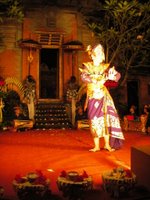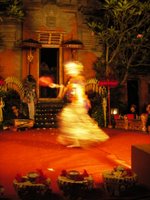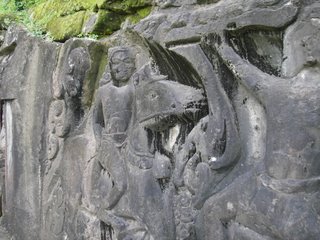

Spring Break ’06 led me to the island paradise of Bali. I’d heard how crowded and touristy Bali was, how I’d hate it, but the rainy season and previous terrorist attacks proved those predictions false. Along with Seb, a half-French Englishman living in Karatsu, Japan, I started my trip in Ubud. We stayed at a dirt cheap family-run guesthouse, sharing a basic room with a number of insects and a mouse. At approximately 3.50 USD per person per night (including breakfast), we had no reason to complain.
Ubud is Bali’s cultural capitol, and for an island whose every corner is oozing with tradition and spirituality, that means a lot. Ubud is full of art galleries and museums, is surrounded by temples, and is host to nightly dances celebrating ancient Hindu texts with a Balinese tilt. We took in three of these dances while in Ubud, one for each night there. The Legong dance is graceful and sad, the story of maiden taken captive by an arrogant king who refuses to release her and is later killed in battle.
In the Barong dance the good Barong, a strange half-lion, half-dog animal, goes to battle with the evil Rangda, a sort of witch.
The final dance we saw was the epic Ramayana Ballet. Though the newest of the Balinese dances, it too is based on ancient text. Like the Legong, this dance tells the story of kidnapping of a maiden and the effort of her family, friends, and several guardian gods to steal her back. It was a bit too complex for my taste with lots of scene changes and characters coming in and out. Very beautiful nonetheless.
For those that don’t know, the Balinese are Hindu in the world’s largest Islamic country. At one time Hinduism was a potent force throughout the Indonesian archipelago, but most islands became Islamic from the fifteenth century onward. As Islam spread and the Hindu kingdoms collapsed, many of the intelligentsia and Brahmana (priests) fled to Bali, taking a rich Hindu tradition with them. Bali experienced a sort of renaissance, its traditional animism fusing with this influx, creating a unique and vibrant brand of Hinduism that thrives to this day. Like traditional Hinduism, the Balinese believe in the trinity of gods Brahma, Shiva and Vishnu, but they also believe that various spirits are ever present and prolific. Abundant shrines and daily offerings (shown below) to appease these entities are a constant reminder of this.
Honestly, you can’t escape from Balinese religion even if you want to: it is everywhere. Each village typically has three temples, one for the village founders, one for the dead, and one for the spirits that protect the villagers. These temples are usually only open on the full moon or bi-annually, both of which are occasions for celebration and ceremony. In addition, each family’s home has its own temple, always in the corner of the walled compound closest to Gunung Agung, Bali’s highest and most revered mountain. The family temple holds such significance that it is used to identify oneself in place of a surname. That’s right, the Balinese don’t have actual surnames; they go by “temple”. On a side note, Balinese first names are given by birth order: Wayan (first child), Made (second), Nyoman (third), and Ketut (fourth). The cycle repeats itself for the fifth child onward. Personalized names do exist, but are used only amongst friends.
But back to Balinese Hinduism and particularly temples. We saw a slew of temples during our three days in Ubud, and had to wear a sarong (think skirt) to all. As with the cathedrals of Europe, once you’ve seen a few their attraction starts to wane. However, unlike many cathedrals, the temples of Bali tend to be a bit more varied. Goa Gajah dates to the 11th century. It contains a T-shaped cave with a demon’s mouth acting as a doorway. An earthquake in 1917 destroyed one shrine, tossing it in a nearby river where it lies to this day.
Tampaksiring’s Tirta Empul is one of Bali’s most important temples. Its spring feeds a crystal clear pool teeming with fish which in turn supplies bathing water to those seeking cures for a variety of ailments.


The town of Bangli is home to Pura Kehen, a large temple perched on a terraced hillside. The design is said to be a miniature version of Pura Besakih, Bali’s grandest and most important temple on the slopes of Gunung Agung.
Now these were all spectacular temples, but my favorite was the temple complex known as the Monkey Forest. It’s not a clever name; there are monkeys. 128 macaques to be exact. They have the run of the place, charged with guarding the ground’s three separate temples and numerous shrines. I’m not sure if they were actually doing this, but they were extremely aggressive towards anyone who had food. I didn’t make this mistake. I just laughed at others who did. This alpha male swiped two bananas off a screaming Russian woman.
Aside from temples, there are a few historical sites more of archaeological significance. The serene but rarely visited Yeh Pulu is near Goa Gajah. It consists of fourteen stone panels displaying scenes of a hunt, a royal court, and certain deities. Two little girls were our guides.

We also spent some time in and around Ubud taking in Bali’s famous rice terraces. Living in Japan’s countryside, I’m no stranger to rice fields. Bali’s however, lacked the cement culverts, metal piping, and pumps that dot Japan’s farms. In other words, the land looked unmolested, yet orderly and thriving. One tour we were on explained the particulars of managing the terraces. Water flow is regulated by a local chapter of farmers. Anyone who wants to farm must become a member. Typically, the farmers living at the bottom of the hillside will be in charge of managing the water, the logic being that they are unlikely to mismanage it as doing so would harm those receiving the water last the most, i.e. themselves. Also, most large fields are owned by wealthier families who contract labor to plant, maintain and harvest the rice. These workers are paid not in cash but in the very rice they harvest; another incentive to do a good job.

Leaving Ubud, we went south to the island of Nusa Lembongan. The plan was for me to snorkel, Seb to dive, and the both of us to relax on the beach, playing cards, throwing the Frisbee, that sort of thing. It didn’t happen, though through no fault of our own. First, Thursday was Nyepia, the day of rest. An annual event, Nyepia ushers in the New Year according to the traditional Balinese calendar. In the weeks leading up to it, townspeople make elaborate sculptures of demons, bring them to the town square dressed in their ceremonial garments, make speeches followed by offerings to the gods, and then burn their sculptures. It is thought that this purifies the land for the upcoming New Year, though as most of the sculptures are now made of polystyrene and other synthetic materials, it’s likely not working.
The following day, Nyepia, is one of complete inactivity. Nothing is open. No one leaves their homes. Tourists everywhere must stay in their hotel rooms. Inactivity. The reason for this is that the Balinese believe that evil spirits descend on the island during Nyepia. The hope is that when the demons find its streets deserted, its fields and temples empty, they’ll assume that Bali is uninhabited and return to the netherworld. So, we too were inactive. Yes, it pretty much sucked, but at least the tradition has some interesting logic behind it.
Demon sculptures of Nyepia with Reggae influence
Did I mention that it poured on Nyepia? Well, it did. And on Friday too. Visibility being nil for diving, we opted to get off the island and head for the pseudo posh resort town of Sanur. Got a nice hotel room there. One with hot water and cable TV, felt we deserved it. But we really just deserved more rain because it rained on Saturday too. We flew out that night.
Overall, Bali was a great vacation, exactly what I needed minus the rain. For anyone heading there, I’d recommend to avoid Kuta and Sanur, head for Ubud or somewhere off the beaten track. And despite the rain, I don’t mean to knock Nusa Lembongan. It supposedly has fine reefs which compared to the rest of Bali are relatively un-dived. And a monkey.

















